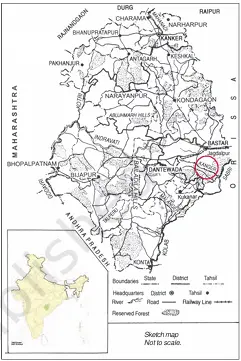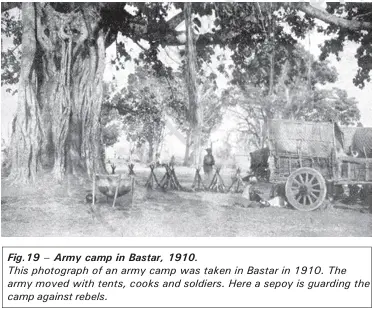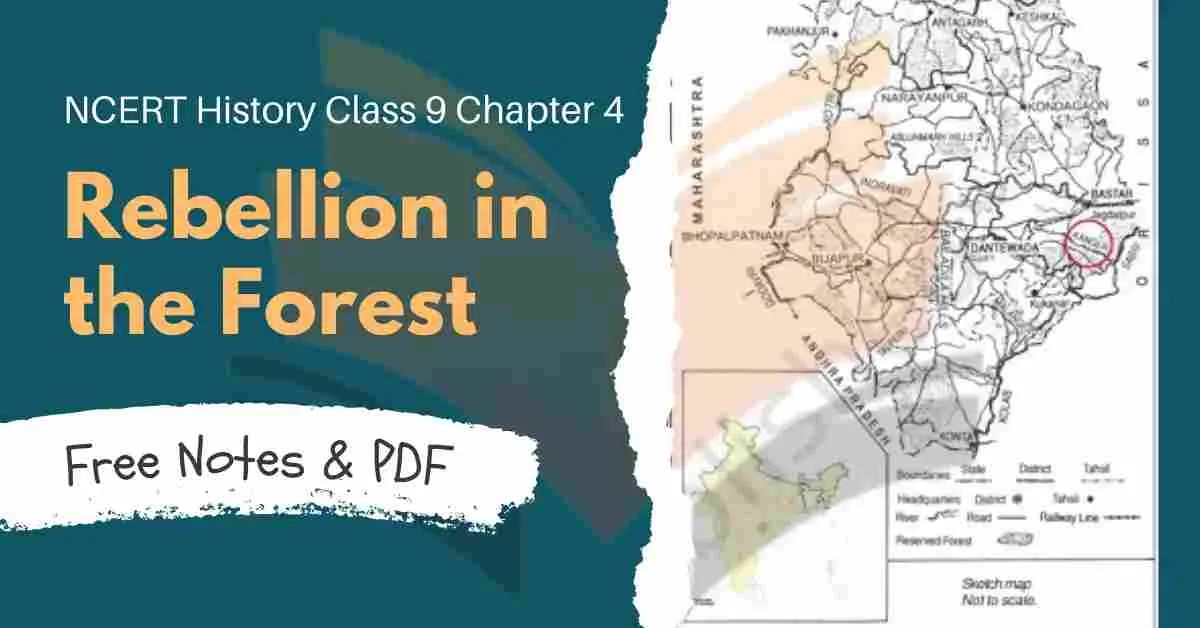Rebellion in the Forest – Concept & Notes PDF
Topic & sub-topics covered: Rebellion in the Forest and MCQs Questions: Forest Society and Colonialism (All single detail notes are exam-oriented).
We have discussed in-depth and exam-oriented pointers that can be asked in the board exam of class 9th about the “Rebellion in the Forest” from the NCERT History notes for class 9th chapter 4th “Forest Society and Colonialism“.
Download the NCERT History for Class 9th Chapter 4 Forest Society and Colonialism Notes PDF
NCERT History for Class 9th Chapter 4_ Forest Society and Colonialism Notes & MCQ’s Question-Answer
Preparing for Class 9 History? Chapter 4 Forest Society and Colonialism is an important topic that explains how colonial rule transformed forests, the lives of people who depended on them, and the environment itself. To make your preparation easier, we’ve created well-structured notes that highlight key events, important terms, and exam-oriented points in a simple way. With these notes, you can revise quickly and understand concepts like Deforestation, shifting cultivation, colonial policies, and resistance by forest communities. Download the NCERT History Class 9 Chapter 4 Forest Society and Colonialism Notes PDF and get everything you need for clear, focused exam preparation in one place.
Rebellion in the Forest

1. Reason for Rebellions:
- Forest communities in India and across the world rebelled against the changes imposed on them by the colonial government (such as restrictions on forest use, exploitation, and loss of livelihood).
2. Famous Tribal Leaders Who Led Rebellions in India:
- Siddhu and Kanu – led the Santhal rebellion in the Santhal Parganas.
- Birsa Munda – led a movement in Chhotanagpur (Munda Rebellion).
- Alluri Sitarama Raju – led the tribal uprising in Andhra Pradesh.
3. Cultural Memory of Leaders:
- These leaders are still remembered in songs and stories by the people for their resistance against the British.
4. Important Case Study Mentioned:
- The text introduces one detailed example: the Bastar Rebellion of 1910.
- Took place in the kingdom of Bastar (present-day Chhattisgarh region).
The People of Bastar

1. Geographical Location of Bastar:
- Bastar is in the southernmost part of Chhattisgarh.
- Borders: Andhra Pradesh, Orissa (Odisha), and Maharashtra.
- Central Bastar: located on a plateau.
- To the north → Chhattisgarh plain.
- To the south → Godavari plain.
- The Indrawati River flows east to west across Bastar.
2. Communities of Bastar:
- Major tribes/communities:
a. Maria Gonds
b. Muria Gonds
c. Dhurwas
d. Bhatras
e. Halbas - They speak different languages but share common customs and beliefs.
3. Religious and Cultural Beliefs:
- People believed each village was given land by the Earth.
- In return, they took care of the Earth by offering gifts during agricultural festivals.
- They also showed respect to spirits of rivers, forests, and mountains.
4. Management of Natural Resources:
- Each village knew its boundaries and managed natural resources within it.
- To collect wood from another village’s forest → outsiders paid a small fee called: Devsari / Dand / Man.
- Some villages appointed watchmen to protect forests.
a. Each household contributed grain to pay the watchmen.
5. Social Practices:
- Annual Big Hunt:
a. Headmen of different villages in a pargana (cluster of villages) met.
b. They discussed important issues, including management of forests.
The Fears of the People
1. Causes of People’s Fear & Anger:
- In 1905, colonial government proposed to reserve two-thirds of forests.
- Banned traditional activities:
a. Shifting cultivation
b. Hunting
c. Collection of forest produce - Villagers forced into free labour for forest department → cutting trees, transporting timber, protecting from fire.
a. Such settlements became known as “Forest Villages”. - Other villages faced displacement without notice or compensation.
- Long-term grievances:
a. Increased land rents.
b. Frequent demands of free labour and goods by colonial officials. - Terrible famines:
a. 899–1900
b. 1907–1908 - Forest reservation became the “last straw” for villagers.
2. Spread of Rebellion:
- Villagers discussed issues in:
a. Village councils
b. Bazaars
c. Festivals
d. Meetings of headmen and priests. - Initiative first taken by Dhurwas of Kanger forest (where reservation started).
- No single leader, but Gunda Dhur of village Nethanar emerged as an important figure.
- Symbols of Rebellion (Messages Passed):
a. Mango boughs
b. Lump of earth
c. Chillies
d. Arrows - Each village contributed to rebellion expenses.
3. Events of the 1910 Bastar Rebellion:
- Bazaars were looted.
- Houses of officials and traders were burnt and robbed.
- Schools and police stations attacked.
- Grain redistributed among people.
- Targets: those associated with colonial state and oppressive laws.
- Missionary William Ward wrote: “From all directions came streaming into Jagdalpur, police, merchants, forest peons, schoolmasters and immigrants.”
4. Suppression by the British:
- British sent troops to crush rebellion.
- Adivasi leaders tried to negotiate, but were attacked.
- Villages flogged and punished.
- Many villagers fled to jungles.
- Duration: Took three months (Feb–May 1910) for British to regain control.
- Gunda Dhur was never captured.
5. Outcome of the Rebellion:
- Major victory for rebels:
a. Forest reservation work was temporarily suspended.
b. Area to be reserved was reduced to half of what was planned before 1910.
6. Aftermath & Continuity after Independence:
- Even after 1947, practice of keeping people out of forests and reserving them for industrial use continued.
- In the 1970s, World Bank proposed: Replace 4,600 hectares of natural sal forests with tropical pine for paper industry.
- Stopped after protests by local environmentalists.
Source E: Account from DeBrett (Political Agent, 1910)
- Leader of the rebels: Bhondia Majhi collected 400 men.
- Religious rituals: Goats were sacrificed before starting the rebellion.
- Targets of attack:
a. Burnt Marenga school, police post, lines, and pound at Keslur.
b. Burnt Tokapal (Rajur) school.
c. Detached a group to burn Karanji school. - Capture of police officials:
a. Captured a head constable and four constables of the State reserve police.
b. Rebels did not maltreat them but took away their weapons and released them. - Strategic moves:
a. One group blocked Koer river passage in case the Dewan took that route.
b. The rest stopped the main road from Bijapur at Dilmilli. - Other rebel leaders: Buddhu Majhi and Harchand Naik led the main body.
Source F: Oral Traditions & Elders’ Memories
1. Podiyami Ganga’s account (based on his father Podiyami Tokeli):
- Cause: British started taking land while the Raja ignored the situation.
- People resisted: Supporters of the Raja gathered and started a war against the British.
- Consequences:
- Staunch supporters died, others were whipped.
- Rebels were tied to horses and dragged by the British.
- Participation: 2–3 people from every village joined at Jagdalpur.
- Examples of rebels: Gargideva, Michkola, Dole, Adrabundi, Vadapandu, Unga, etc.
2. Chendru’s account (elder from Nandrasa):
- People’s leaders: Mille Mudaal (Palem), Soyekal Dhurwa (Nandrasa), Pandwa Majhi.
- Mass participation: People from every pargana camped in Alnar Tarai.
- British attack: Army paltan surrounded the people suddenly at night.
- Beliefs: Gunda Dhur had “flying powers” and escaped.
- Rebel disadvantage: With bows and arrows against British guns, they suffered.
- Outcome: Many rebels hid in shrubs and escaped, but many died.
Next & Previous Topics of NCERT/CBSE History Class 9 Chapter 4: Forest Society and Colonialism
| Topics No. | Topics Name |
|---|---|
| 1 | Why Deforestation? |
| 2 | The Rise of Commercial Forestry |
| 3 | Rebellion in the Forest |
| 4 | Forest Transformations in Java |
MCQs on NCERT History Class 9 Chapter 4 Topic – Rebellion in the Forest
Here are the top exam-oriented MCQ-type questions on “Rebellion in the Forest” that you should prepare for your CBSE or state board exams:
Question 1. In which year did the Bastar rebellion against the British take place?
a) 1905
b) 1910
c) 1915
d) 1920
Answer: b) 1910
Question 2. Who among the following was an important figure in the Bastar rebellion?
a) Birsa Munda
b) Gunda Dhur
c) Siddhu Murmu
d) Alluri Sitarama Raju
Answer: b) Gunda Dhur
Question 3. The Bastar region is located in the southernmost part of which present-day state?
a) Maharashtra
b) Odisha
c) Chhattisgarh
d) Andhra Pradesh
Answer: c) Chhattisgarh
Question 4. Which river flows across Bastar from east to west?
a) Godavari
b) Indrawati
c) Narmada
d) Mahanadi
Answer: b) Indrawati
Question 5. The communities like Maria and Muria Gonds, Dhurwas, Bhatras, and Halbas lived in which region?
a) Santhal Parganas
b) Chhotanagpur
c) Bastar
d) Andhra Pradesh
Answer: c) Bastar
Question 6. What was the fee called when villagers wanted to take wood from another village’s forest?
a) Lagaan
b) Devsari / Dand / Man
c) Tehbazari
d) Bhent
Answer: b) Devsari / Dand / Man
Question 7. In which year did the colonial government propose to reserve two-thirds of Bastar forests?
a) 1900
b) 1905
c) 1907
d) 1911
Answer: b) 1905
Question 8. What were the villages called where people had to work free for the forest department?
a) Ryotwari villages
b) Permanent villages
c) Forest villages
d) Zamindari villages
Answer: c) Forest villages
Question 9. Which terrible famines worsened the condition of Bastar villagers?
a) 1885-1886 and 1890-1891
b) 1899-1900 and 1907-1908
c) 1910-1911 and 1915-1916
d) 1920-1921 and 1925-1926
Answer: b) 1899-1900 and 1907-1908
Question 10. What symbols circulated between Bastar villages to invite people to rebel?
a) Rice and turmeric
b) Mango boughs, lump of earth, chillies and arrows
c) Flowers and coins
d) Salt and sugar
Answer: b) Mango boughs, lump of earth, chillies and arrows
Question 11. Which town saw police, merchants, forest peons, and immigrants fleeing during the rebellion?
a) Bijapur
b) Jagdalpur
c) Tokapal
d) Alnar
Answer: b) Jagdalpur
Question 12. Who observed and recorded the Bastar rebellion as a missionary?
a) William Ward
b) DeBrett
c) Susobhan Sarkar
d) James Mill
Answer: a) William Ward
Question 13. How long did it take for the British to regain control during the Bastar rebellion?
a) One month
b) Two months
c) Three months
d) Six months
Answer: c) Three months
Question 14. Which rebel leader was never captured by the British?
a) Gunda Dhur
b) Bhondia Majhi
c) Mille Mudaal
d) Soyekal Dhurwa
Answer: a) Gunda Dhur
Question 15. After the rebellion, what happened to the forest reservation plan?
a) It was fully implemented
b) Suspended temporarily and reduced to half
c) Expanded further
d) Abandoned forever
Answer: b) Suspended temporarily and reduced to half
Question 16. In the 1970s, which international organisation proposed replacing Bastar’s sal forests with tropical pine?
a) IMF
b) United Nations
c) World Bank
d) Asian Development Bank
Answer: c) World Bank
Question 17. The tropical pine plantations were proposed for which industry?
a) Textile
b) Ship-building
c) Paper industry
d) Iron and steel
Answer: c) Paper industry
Question 18. Who among the following led rebels to burn schools and police posts in 1910? (Source E)
a) Podiyami Tokeli
b) Bhondia Majhi
c) Soyekal Dhurwa
d) Mille Mudaal
Answer: b) Bhondia Majhi
Question 19. According to oral traditions, which rebel leader was believed to have “flying powers”? (Source F)
a) Soyekal Dhurwa
b) Gunda Dhur
c) Pandwa Majhi
d) Mille Mudaal
Answer: b) Gunda Dhur
Question 20. The rebellion in Bastar was mainly a struggle against:
a) Indian landlords
b) British colonial forest policies
c) Local kings
d) Zamindars of Bengal
Answer: b) British colonial forest policies

